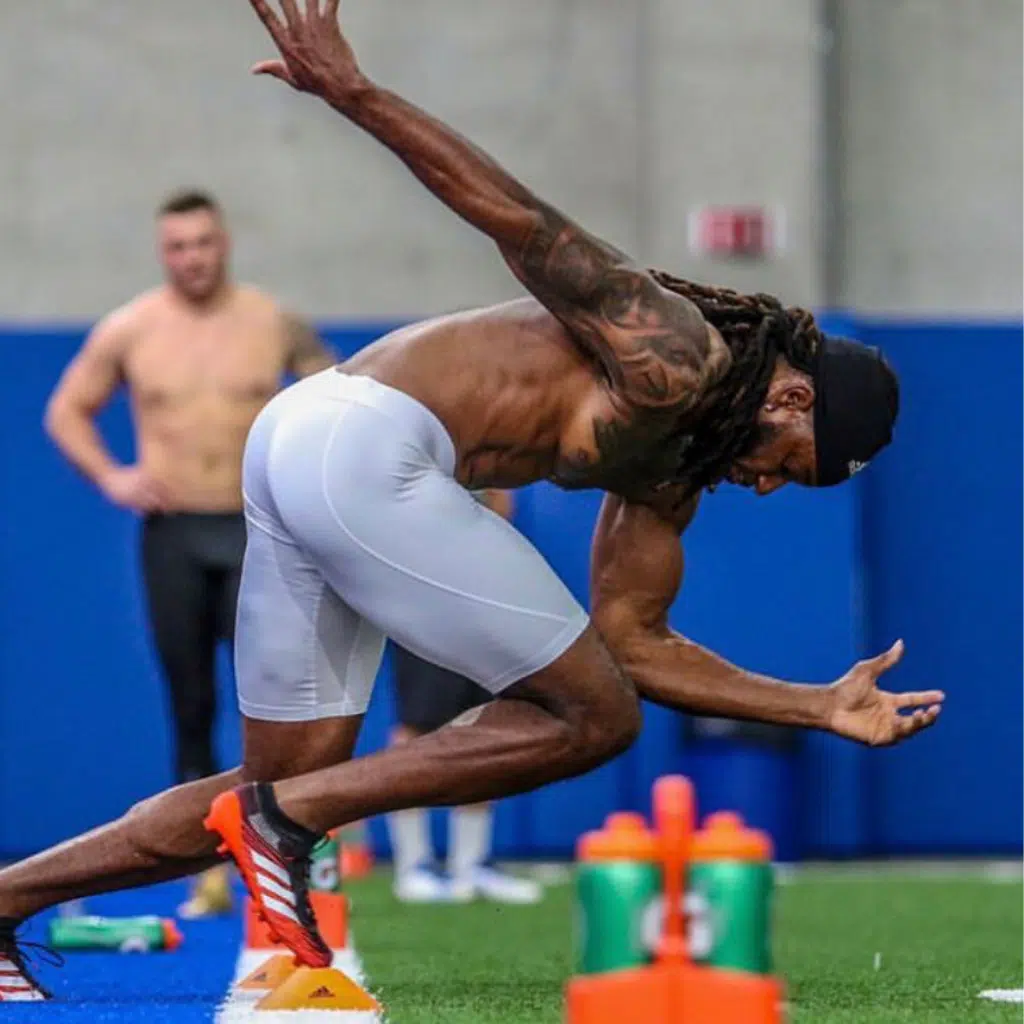The 40-yard dash is the SAT of college football. It’s a basically standardized test that all high school football players must take if they hope to play in college or get drafted in the NFL. It’s not necessarily indicative of an athlete’s ability on the field but is often a prerequisite for coaches to open the door for further evaluation. If you’re not prepared, you’re in trouble.
Just like any other test, the 40 is something that should be understood and studied for. You wouldn’t walk into an SAT exam without any prep work right? (God I hope not). Today, we are going to give some tips and techniques that will help you prepare to light up those stopwatches and get the scouts buzzing.
The Start
Pick the Right Stance for YOU
Let’s start with the 40 stance. A good stance, will set you up to run a fast race. If you don’t have a good stance, you’re done.
One common mistake that many athletes make is picking a “one size fits all” stance. You have to remember that every athlete is going to be slightly different. Factors such a body type and mobility are going to affect each individual’s stance to some degree.
While there are factors that will make each stance slightly different, below are a couple guidelines that everyone should follow:
-
Get in a stance where you feel explosive: You want to pick a stance where you can “jump out” of
-
Put heavy pressure on your hand (P.S. – this should not feel comfortable): You want to position yourself so your first step is out and not up
Practice Firing Out
One of the biggest mistakes an athlete can do is to wait till their timed 40 to fire out of their stance. The start of your race is the most important and you want to make sure you fire out a couple times prior to being time. Think of it as a rehearsal before the performance.
Make sure you limit your fire out, to between 5 and10 yards to not over-fatigue yourself. Running the whole 40 yards as a rehearsal is a BAD idea. Perform 2-3 fire outs prior to running.
One of our athletes from our 2018 combine class who ran a 4.39 at his pro day
The Race
Fire Out and Gradually Rise
After the race has started, the phase is extremely important. The transition is when you transition from acceleration to top-end speed. When you accelerate you should have a heavy lean forward, but at some point you have to transition to top end speed, which is more upright. You want that transition to be smooth and gradual, not sudden. Think of an airplane taking off the runway, then gradually reaching altitude
Don’t Run a 40, Run a 45
When we say “run 45 yards”, what we are really saying is run past the finish line. This is due to 2 common mistakes that athletes make.
-
Slowing down before the finish line
-
Lunging at the finish line
Often times athletes will run 38 yards and start decelerating the last couple. This is a big mistake as this will add valuable time to your 40. Remember, we are in a race with the clock here, and you always want to make sure you run through your target.
Another common mistake is lunging at the finish line. Lunging at the finish line may seem like a good time-saving strategy at first, but in reality, the flight time that the athlete is in the air is slower than the athlete actually sprinting through the finish line.
Think of it in terms of a baseball player sprinting to first and trying to beat out a throw. Baseball coaches will tell you always want to run through the base, rather than lunging or diving at it.
The Night Before The Race
Don’t Cram For the Test
Using the SAT analogy again, cramming the night before a big exam is one of the worst things you can do. By this point, the work should already be done, and you should be in a mindset for success. Speaking from experience, cramming the night before any test is not a good strategy. Think of training for the 40 the same way.
Instead of trying to work your hardest in the days leading up to the race, you should actually be decreasing your training load. You want to be as fresh as possible on the day of the event. Sprinting 40 yards at full speed is very physically and neurologically taxing. Especially when you consider the mental stress of competing at such a an important event in front of scouts, coaches, etc.
Being fresh and well-rested is much more important than any perceived benefits you may get from a last-minute training session. Be sure to be fully hydrated and sleep a full 8 hours the night before the event.
When it come to running a successful 40, there is a lot that more to it that we can simply layout in this article. But this is a good start.
In addition to the 40, most scouting events will want their athletes to at least do a pro-agility, broad jump, and vertical jump. If you are interested in going more in depth into combine training, click here.







